|
Fortifications Interpretation Centre
The Fortress Builders – Fortification Interpretation Centre (FIC) is an interpretation centre about the fortifications of Malta. It is housed in a late 16th-century warehouse located near the Fortifications of Valletta#Marsamxett enceinte, St. Andrew's Bastion in Valletta, Malta. The centre was opened in 2013, and it aims at communicating Malta's military architecture in an interactive way. The building was formerly known as the Biagio Steps Examination Centre. History The idea to establish a museum about Malta's military architecture goes back to the 1960s, when British architect Quentin Hughes (architect), Quentin Hughes proposed to set up such a museum in Fort San Lucian. Military historian Stephen C. Spiteri also made plans to establish a military architecture museum, and he proposed setting it up at the Ospizio in Floriana. In November 2008, the Ministry for Resources and Rural Affairs under Minister George Pullicino took the initiative of setting up the museum at the forme ... [...More Info...] [...Related Items...] OR: [Wikipedia] [Google] [Baidu] |
Fortifications Interpretation Centre Logo
A fortification is a military construction or building designed for the defense of territories in warfare, and is also used to establish rule in a region during peacetime. The term is derived from Latin ''fortis'' ("strong") and ''facere'' ("to make"). From very early history to modern times, defensive walls have often been necessary for cities to survive in an ever-changing world of invasion and conquest. Some settlements in the Indus Valley civilization were the first small cities to be fortified. In ancient Greece, large stone walls had been built in Mycenaean Greece, such as the ancient site of Mycenae (famous for the huge stone blocks of its 'cyclopean' walls). A Greek ''Towns of ancient Greece#Military settlements, phrourion'' was a fortified collection of buildings used as a military garrison, and is the equivalent of the ancient Roman, Roman castellum or English language, English fortress. These constructions mainly served the purpose of a watch tower, to guard certa ... [...More Info...] [...Related Items...] OR: [Wikipedia] [Google] [Baidu] |
European Regional Development Fund
The European Regional Development Fund (ERDF) is one of the European Structural and Investment Funds allocated by the European Union. Its purpose is to transfer money from richer regions (not countries), and invest it in the infrastructure and services of underdeveloped regions. This will allow those regions to start attracting private sector investments, and create jobs on their own. History During the 1960s, the European Commission occasionally tried to establish a regional fund, but only Italy ever supported it. Britain made it an issue for its accession in 1973, and pushed for its creation at the 1972 summit in Paris. Britain was going to be a large contributor to the CAP and the EEC budget, and sought to offset this deficit by having the ERDF established. They would then be able to show their public some tangible benefits of EEC membership. The ERDF was set to be running by 1973, but the 1973 oil crisis delayed it, and it was only established in 1975 under considerable Brit ... [...More Info...] [...Related Items...] OR: [Wikipedia] [Google] [Baidu] |
Bronze Age
The Bronze Age is a historic period, lasting approximately from 3300 BC to 1200 BC, characterized by the use of bronze, the presence of writing in some areas, and other early features of urban civilization. The Bronze Age is the second principal period of the three-age system proposed in 1836 by Christian Jürgensen Thomsen for classifying and studying ancient societies and history. An ancient civilization is deemed to be part of the Bronze Age because it either produced bronze by smelting its own copper and alloying it with tin, arsenic, or other metals, or traded other items for bronze from production areas elsewhere. Bronze is harder and more durable than the other metals available at the time, allowing Bronze Age civilizations to gain a technological advantage. While terrestrial iron is naturally abundant, the higher temperature required for smelting, , in addition to the greater difficulty of working with the metal, placed it out of reach of common use until the end o ... [...More Info...] [...Related Items...] OR: [Wikipedia] [Google] [Baidu] |
17th-century Drawbridge Of Valletta
The 17th century lasted from January 1, 1601 ( MDCI), to December 31, 1700 ( MDCC). It falls into the early modern period of Europe and in that continent (whose impact on the world was increasing) was characterized by the Baroque cultural movement, the latter part of the Spanish Golden Age, the Dutch Golden Age, the French '' Grand Siècle'' dominated by Louis XIV, the Scientific Revolution, the world's first public company and megacorporation known as the Dutch East India Company, and according to some historians, the General Crisis. From the mid-17th century, European politics were increasingly dominated by the Kingdom of France of Louis XIV, where royal power was solidified domestically in the civil war of the Fronde. The semi-feudal territorial French nobility was weakened and subjugated to the power of an absolute monarchy through the reinvention of the Palace of Versailles from a hunting lodge to a gilded prison, in which a greatly expanded royal court could be mo ... [...More Info...] [...Related Items...] OR: [Wikipedia] [Google] [Baidu] |
Sustainable Architecture
Sustainable architecture is architecture that seeks to minimize the negative environmental impact of buildings through improved efficiency and moderation in the use of materials, energy, development space and the ecosystem at large. Sustainable architecture uses a conscious approach to energy and ecological conservation in the design of the built environment. The idea of sustainability, or ecological design, is to ensure that our use of presently available resources does not end up having detrimental effects to our collective well-being or making it impossible to obtain resources for other applications in the long run. Background Shift from narrow to broader approach The term "sustainability" in relation to architecture has so far been mostly considered through the lens of building technology and its transformations. Going beyond the technical sphere of "green design", invention and expertise, some scholars are starting to position architecture within a much broader cultura ... [...More Info...] [...Related Items...] OR: [Wikipedia] [Google] [Baidu] |
Fortifications Of Valletta
The fortifications of Valletta ( mt, Is-Swar tal-Belt Valletta) are a series of defensive walls and other fortifications which surround Valletta, the capital city of Malta. The first fortification to be built was Fort Saint Elmo in 1552, but the fortifications of the city proper began to be built in 1566 when it was founded by Grand Master Jean de Valette. Modifications were made throughout the following centuries, with the last major addition being Fort Lascaris which was completed in 1856. Most of the fortifications remain largely intact today. The city of Valletta, along with Nicosia in Cyprus, was considered to be a practical example of an ideal city of the Renaissance, and this was due to its fortifications as well as the urban life within the city. The fortifications were well known throughout Europe by the 17th century, and might have influenced the designs of part of the Fortress of Luxembourg. In an 1878 book, Valletta was described as "one of the best fortified ities ... [...More Info...] [...Related Items...] OR: [Wikipedia] [Google] [Baidu] |
World War II
World War II or the Second World War, often abbreviated as WWII or WW2, was a world war that lasted from 1939 to 1945. It involved the vast majority of the world's countries—including all of the great powers—forming two opposing military alliances: the Allies and the Axis powers. World War II was a total war that directly involved more than 100 million personnel from more than 30 countries. The major participants in the war threw their entire economic, industrial, and scientific capabilities behind the war effort, blurring the distinction between civilian and military resources. Aircraft played a major role in the conflict, enabling the strategic bombing of population centres and deploying the only two nuclear weapons ever used in war. World War II was by far the deadliest conflict in human history; it resulted in 70 to 85 million fatalities, mostly among civilians. Tens of millions died due to genocides (including the Holocaust), starvation, ma ... [...More Info...] [...Related Items...] OR: [Wikipedia] [Google] [Baidu] |
University Of Manchester
, mottoeng = Knowledge, Wisdom, Humanity , established = 2004 – University of Manchester Predecessor institutions: 1956 – UMIST (as university college; university 1994) 1904 – Victoria University of Manchester 1880 – Victoria University 1851 – Owens College 1824 – Manchester Mechanics' Institute , endowment = £242.2 million (2021) , budget = £1.10 billion (2020–21) , chancellor = Nazir Afzal (from August 2022) , head_label = President and vice-chancellor , head = Nancy Rothwell , academic_staff = 5,150 (2020) , total_staff = 12,920 (2021) , students = 40,485 (2021) , undergrad = () , postgrad = () , city = Manchester , country = England, United Kingdom , campus = Urban and suburban , colours = Manchester Purple Manchester Yellow , free_label = Scarf , free = , website = , logo = UniOfManchesterLogo.svg , affiliations = Universities Research Association Sutton 30 Russell Group EUA N8 Group NWUA ACUUniversities UK The Universit ... [...More Info...] [...Related Items...] OR: [Wikipedia] [Google] [Baidu] |
Gunpowder Magazine
A gunpowder magazine is a magazine (building) designed to store the explosive gunpowder in wooden barrels for safety. Gunpowder, until superseded, was a universal explosive used in the military and for civil engineering: both applications required storage magazines. Most magazines were purely functional and tended to be in remote and secure locations. They are the successor to the earlier powder towers and powder houses. In Australia Historic magazines were at the following locations, among others: *Jack's Magazine, Saltwater River, Victoria * Goat Island, Sydney *Spectacle Island (Port Jackson) *North Arm Powder Magazine *Dry Creek explosives depot In Canada There are magazines at: *Citadel Hill (Fort George) *Citadel of Quebec, Quebec City, Quebec *Parc de l'Esplanade, Quebec City, QuebecCole Island Esquimalt, British Columbia *Fort Lennox, Île-aux-Noix, Quebec *Fort William Historical Park, Thunder Bay, Ontario *Fort York, Toronto In Ireland Ballincollig, County Cork ... [...More Info...] [...Related Items...] OR: [Wikipedia] [Google] [Baidu] |
Hugues Loubenx De Verdalle
Fra' Hugues Loubenx de Verdalle (13 April 1531 – 4 May 1595) was the 51st Grand Master of the Order of Malta, between 1582 and 1595. History He is mainly remembered for the reconstruction of the hunting lodge at Boschetto which was renamed Verdala Palace in his honour. He is buried in a sarcophagus in the Crypt of the Co-Cathedral of St. John in Valletta. He was made Cardinal-Deacon of S. Maria in Portico Octaviae by Pope Sixtus V in the consistory Consistory is the anglicized form of the consistorium, a council of the closest advisors of the Roman emperors. It can also refer to: *A papal consistory, a formal meeting of the Sacred College of Cardinals of the Roman Catholic Church * Consistor ... of December 18, 1587. References External links Coins of Grandmaster Hugues Loubenx de Verdalle Grand Masters of the Knights Hospitaller Knights of Malta 1531 births 1595 deaths 16th-century French cardinals Burials at Saint John's Co-Cathedral {{Malta-bi ... [...More Info...] [...Related Items...] OR: [Wikipedia] [Google] [Baidu] |
16th-century Fortification Interpretation Centre
The 16th century begins with the Julian year 1501 ( MDI) and ends with either the Julian or the Gregorian year 1600 ( MDC) (depending on the reckoning used; the Gregorian calendar introduced a lapse of 10 days in October 1582). The 16th century is regarded by historians as the century which saw the rise of Western civilization and the Islamic gunpowder empires. The Renaissance in Italy and Europe saw the emergence of important artists, authors and scientists, and led to the foundation of important subjects which include accounting and political science. Copernicus proposed the heliocentric universe, which was met with strong resistance, and Tycho Brahe refuted the theory of celestial spheres through observational measurement of the 1572 appearance of a Milky Way supernova. These events directly challenged the long-held notion of an immutable universe supported by Ptolemy and Aristotle, and led to major revolutions in astronomy and science. Galileo Galilei became a c ... [...More Info...] [...Related Items...] OR: [Wikipedia] [Google] [Baidu] |









